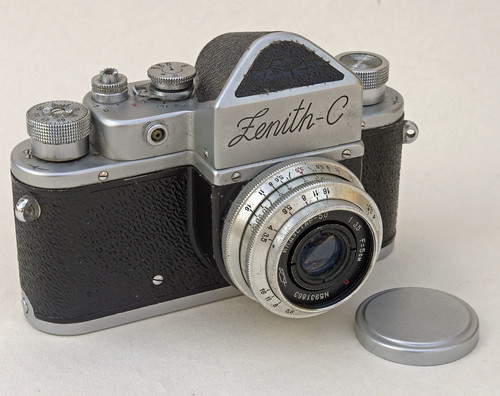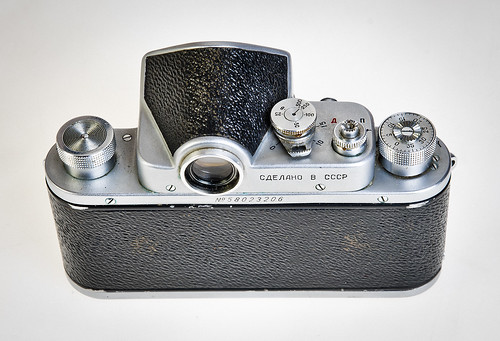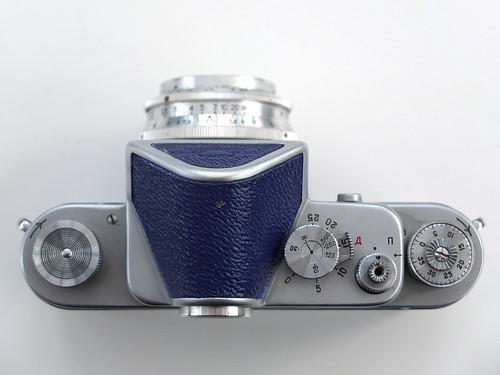Difference between revisions of "Zenit C"
| Line 12: | Line 12: | ||
==Description== | ==Description== | ||
| − | Substantially, the camera is a member of the extended [[Leica]] family, with the early Zenits being based on the rangefinder [[Zorki]], itself based on the original [[ | + | Substantially, the camera is a member of the extended [[Leica]] family, with the early Zenits being based on the rangefinder [[Zorki]], itself based on the original [[FED 1]], a direct copy of the [[Leica II]]. In many ways, the continuity between the Leica and the Zenit, while they are different types of camera made in different countries at different times, is very tangible in several aspects of the Zenit, most notably the physical shape of the body and the bottom-loading film chamber, which requires the exact same precautions and procedure as for a Leica. |
To wit, film is loaded by removing the base of the camera, not opening the back. The film must be prepared: more film must be cut away from the leader to extend the length of the "tongue." Care must be taken not to leave a hard corner when doing this. The mechanical intricacies of the advance mechanism can result in film with an untrimmed leader being chewed up by the camera, which can result in chips of film going into the shutter and possibly ruining it. | To wit, film is loaded by removing the base of the camera, not opening the back. The film must be prepared: more film must be cut away from the leader to extend the length of the "tongue." Care must be taken not to leave a hard corner when doing this. The mechanical intricacies of the advance mechanism can result in film with an untrimmed leader being chewed up by the camera, which can result in chips of film going into the shutter and possibly ruining it. | ||
| Line 26: | Line 26: | ||
The shutter is a very basic mechanism common to many SLR's and rangefinders of the early 20th century, based ultimately on that of the Leica. The shutter-speed dial rotates in one direction when advancing the film, then spins rapidly in the other direction as the shutter is released. To set it, the dial must be lifted up slightly, turned and set back into place at the desired position. The speeds are B (which can give time exposures by locking the shutter release down) plus 1/25th (or 1/30th) to 1/500, with no slow-speed gearing for any lower speeds. The tension of the curtain mainsprings may be changed on the underside of the camera with the bottom off, and thus a semi-skilled technician can fix uneven exposure if the correct procedure is followed. | The shutter is a very basic mechanism common to many SLR's and rangefinders of the early 20th century, based ultimately on that of the Leica. The shutter-speed dial rotates in one direction when advancing the film, then spins rapidly in the other direction as the shutter is released. To set it, the dial must be lifted up slightly, turned and set back into place at the desired position. The speeds are B (which can give time exposures by locking the shutter release down) plus 1/25th (or 1/30th) to 1/500, with no slow-speed gearing for any lower speeds. The tension of the curtain mainsprings may be changed on the underside of the camera with the bottom off, and thus a semi-skilled technician can fix uneven exposure if the correct procedure is followed. | ||
| − | It is ''imperative'' that the shutter speed is ''only'' set when the shutter has been cocked, and ''never'' in an un-cocked position. This is a problem common to many cameras based on a Leica shutter, but it is especially endemic to Russian designs, so it should be assumed that ''any'' Russian camera suffers from it until it is definitively known otherwise (some Russian leaf shutters even have a similar, technically-unrelated problem). If the shutter speed is changed while uncocked, and the film is then advanced, a pin in the timing mechanism can break, ruining the camera. If it does not break, it may behave erratically for many shots before normalizing. If one accidentally changes the shutter speed while uncocked, usually it is possible to put it back where it was without damage, but it is best to avoid doing it altogether for safety. Additionally, the dial should not be turned between B and 1/500. | + | It is ''imperative'' that the shutter speed is ''only'' set when the shutter has been cocked, and ''never'' in an un-cocked position. This is a problem common to many cameras based on a Leica shutter, but it is especially endemic to Russian designs, so it should be assumed that ''any'' Russian camera suffers from it until it is definitively known otherwise (some Russian leaf shutters even have a similar, technically-unrelated problem). If the shutter speed is changed while uncocked, and the film is then advanced, a pin in the timing mechanism can break, ruining the camera. If it does not break, it may behave erratically for many shots before normalizing. If one accidentally changes the shutter speed while uncocked, usually it is possible to put it back where it was without damage, but it is best to avoid doing it altogether for safety. Additionally, the dial should not be turned through the blank sector between B and 1/500, as it is not designed to turn full circle. |
==Viewfinder== | ==Viewfinder== | ||
Revision as of 21:43, 21 March 2020

|
| Zenit C with Industar-50 and yellow filter image by old_cameras (Image rights) |
The Zenit C[1] is a compact all-mechanical 35 mm SLR camera made in the Soviet Union. It is the second model in the Zenit camera line, following only three years after the original Zenit 1. It was made by Krasnogorskii Mekhanicheskii Zavod (Krasnogorsk Mechanical Works) near Moscow, between 1955 and 1961.[2]
Contents
Description
Substantially, the camera is a member of the extended Leica family, with the early Zenits being based on the rangefinder Zorki, itself based on the original FED 1, a direct copy of the Leica II. In many ways, the continuity between the Leica and the Zenit, while they are different types of camera made in different countries at different times, is very tangible in several aspects of the Zenit, most notably the physical shape of the body and the bottom-loading film chamber, which requires the exact same precautions and procedure as for a Leica.
To wit, film is loaded by removing the base of the camera, not opening the back. The film must be prepared: more film must be cut away from the leader to extend the length of the "tongue." Care must be taken not to leave a hard corner when doing this. The mechanical intricacies of the advance mechanism can result in film with an untrimmed leader being chewed up by the camera, which can result in chips of film going into the shutter and possibly ruining it.
The C model is an incremental update of the Zenit 1, with much of the camera being identical. The most important change is the addition of flash synchronisation via a PC socket on the front of the top superstructure. The synchronisation delay is variable between zero (X-synch.) and 25 milliseconds (M-synch.) with a control under the shutter speed selector. There is no accessory shoe; any flash would have to be mounted on a bracket. Unlike the Zenit 1, film is released for rewind by depressing and rotating the collar around the shutter release button to point at 'B' (on the Zenit 1, the rewind release is a separate, simple lever).
Another difference, not obvious to the user, is the use of a cord to pull the mirror down into position during film advance/shutter cocking, replacing a metal arm which does this job in the Zenit 1[3].
The shutter speed selector is also very slightly different: whereas on the earlier model, the whole selector is rotated to align the desired speed with a mark on the superstructure, on the Zenit C the mark is on the central axis of the selector.
Shutter
The shutter is a very basic mechanism common to many SLR's and rangefinders of the early 20th century, based ultimately on that of the Leica. The shutter-speed dial rotates in one direction when advancing the film, then spins rapidly in the other direction as the shutter is released. To set it, the dial must be lifted up slightly, turned and set back into place at the desired position. The speeds are B (which can give time exposures by locking the shutter release down) plus 1/25th (or 1/30th) to 1/500, with no slow-speed gearing for any lower speeds. The tension of the curtain mainsprings may be changed on the underside of the camera with the bottom off, and thus a semi-skilled technician can fix uneven exposure if the correct procedure is followed.
It is imperative that the shutter speed is only set when the shutter has been cocked, and never in an un-cocked position. This is a problem common to many cameras based on a Leica shutter, but it is especially endemic to Russian designs, so it should be assumed that any Russian camera suffers from it until it is definitively known otherwise (some Russian leaf shutters even have a similar, technically-unrelated problem). If the shutter speed is changed while uncocked, and the film is then advanced, a pin in the timing mechanism can break, ruining the camera. If it does not break, it may behave erratically for many shots before normalizing. If one accidentally changes the shutter speed while uncocked, usually it is possible to put it back where it was without damage, but it is best to avoid doing it altogether for safety. Additionally, the dial should not be turned through the blank sector between B and 1/500, as it is not designed to turn full circle.
Viewfinder
The viewfinder is a fixed-pentaprism design, with a flat ground glass for the focusing screen. The mirror is not quick-return: on cocking the shutter, the mirror descends, and on firing, it rises. This leads to a condition in which the camera must be cocked to view through the viewfinder--while a modern photographer will consider this a disadvantage, the hidden advantage in it lies in the impossibility of missing a shot because the shutter is uncocked--if the mirror is up, a shot cannot be composed in the first place, and so the photographer will get in the habit of re-cocking immediately upon firing.
Lens
The selection of lenses is limited, unfortunately. The Zenit mount is essentially unique to the early Zenits. It is an m39 mount (metric 1-millimeter threading with a diameter of 39mm) like the Leica Thread Mount (and others.) However, it is an SLR mount and the flange distance (i.e., between the film and the mating surface of the lens mount) is therefore much larger, as there is a mirror-box between the shutter and the lens. An LTM (Leica Thread Mount) lens mounted on the camera will only focus extremely close-up, and a Zenit lens mounted on an LTM camera will fail to engage the rangefinder, as it does not have a cam ring, and the focus scale will read incorrectly. The only cameras outside this series that can take Zenit m39 lenses are cameras with an m42 screw mount, which have an identical flange distance and can take a simple double-threaded adapter ring.
The standard lens is either a rigid-bodied 5 cm f/3.5 Industar-22 or the Industar-50 which replaced it from about 1959. Both are coated Tessar-type lenses (Industar was the Soviet name for Tessar-type lenses). Both are somewhat poorly designed for an SLR lens, having more in common with rangefinder lenses. The aperture control is manual on both, with no preset. Furthermore, the aperture ring is at the front, inside the focusing ring. For some examples, it is possible to disturb the focus by stopping down the aperture, and so critical focusing must be done with these lenses while stopped down.

|
| Zenith C for export, with name in Latin script (and with an 'h') image by Dave Dockerill (Image rights) |

|
| image by SBA73 (Image rights) |

|
| Zenit C with I-50 (fitted), Mir-1 wide-angle lens, extension tubes, case, instructions and box. image by Siim Vahur (Image rights) |
Conclusion
While hardly what modern photographers would recognize as a full-featured SLR, the Zenit C is a small, well-built camera with a venerable design lineage. When obtainable cheaply, it can be rewarding as a solidly-built SLR with very few extra features to wear out or break. The limited selection of lenses may be a factor in choosing not to buy it, but the lenses that do exist are Soviet glass from an era when the lens industry in the USSR made good copies of German designs cheaply, and the Industars have a good reputation as being a similar lens to the Leitz Elmar.
Specifications
- Type: 35 mm single-lens reflex camera
- Format: 24x36 mm on standard 135 cartridge film
- Manufacturer: KMZ
- Years of production: 1955-61
- Number produced: Est. 232, 949[4]
- Standard lens: Industar-50 1:3.5 F=5 cm
- Shutter:
- Cloth focal-plane shutter. 1/25 - 1/500 second plus 'B' on early examples; 1/30 - 1/500 second plus 'B' later. Cable release socket in shutter release button. No delayed action.
- Flash synchronisation by PC socket. Variable synchronisation delay, 0-25 ms.
- Viewfinder: Pentaprism viewfinder with ground glass focusing screen. No prismatic focusing aids.
- Dimensions (width x depth x height): 140 x 50 x 90 mm (body only).

|
| Top view. This example has the later shutter speed range image by Tony Kemplen (Image rights) |
Notes
- ↑ The 'C' is a Cyrillic 'S', and refers to the shutter's being synchronised for flash. However, even when in Latin script, the name is marked on the camera as 'Zenith C'.
- ↑ McKeown, James M. and Joan C. McKeown's Price Guide to Antique and Classic Cameras, 12th Edition, 2005-2006. USA, Centennial Photo Service, 2004. ISBN 0-931838-40-1 (hardcover). ISBN 0-931838-41-X (softcover). p. 553.
- ↑ The page on the Zenit 1 'camera line' (in Russian) formerly at the KMZ Archive (http://www.zenitcamera.com) and archived at the Internet Archive 'Wayback Machine' in December 2008, states only that the metal-arm mechanism was 'not very successful'.
- ↑ Production figures formerly shown at the KMZ Archive, and archived at the Internet Archive 'Wayback Machine' in June 2006.